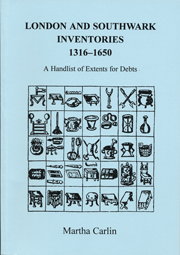 by
Martha Carlin
by
Martha CarlinPublished: December 1997
Price: £6.99
CMH PUBLICATIONS
LISTS AND GUIDES TO SOURCES
Lists of Londoners
Kentish Demesne Accounts up to 1350: A Catalogue
Bibliography of Printed Works on London History to 1939
London and Southwark Inventories 1316-1650: A Handlist of Extents
for Debts
Sources for the History of London 1939-45: A Guide and Bibliography
Unpublished London Diaries. A Checklist
Gazetteer of Markets and Fairs in England and Wales to 1516
COLLECTIONS OF CONFERENCE AND WORKING PAPERS
Epidemic Disease In London
Goldsmith, Silversmiths and
Bankers: Innovation and the Transfer of Skill, 1550 to 1750
Archives and the Metropolis
Trade, Urban Hinterlands and Market Integration c.1300-1600
New Windows on London's Past: Information Technology and
the Transformation of Metropolitan History
Guilds, Society and Economy in London 1450-1800
Re: the archive, the image, and the very dead sheep
Guilds and Association in Europe, 900-1900
Reinventing History: The Enlightenment Origins of Ancient History NEW
MONOGRAPHS
A Medieval Capital and its
Grain Supply: agrarian production and distribution in the London
region c.1300
London's Dreaded Visitation:
the social geography of the Great Plague in 1665
London in
the 1690s: A Social Atlas
Clergy in London in the Late Middle Ages
The History of the Merchant Taylors' Company
COLLECTIVE VOLUMES
St Paul's. The Cathedral Church of London 604-2004
The Religious Houses of London and Middlesex
Lists and Guides to Sources
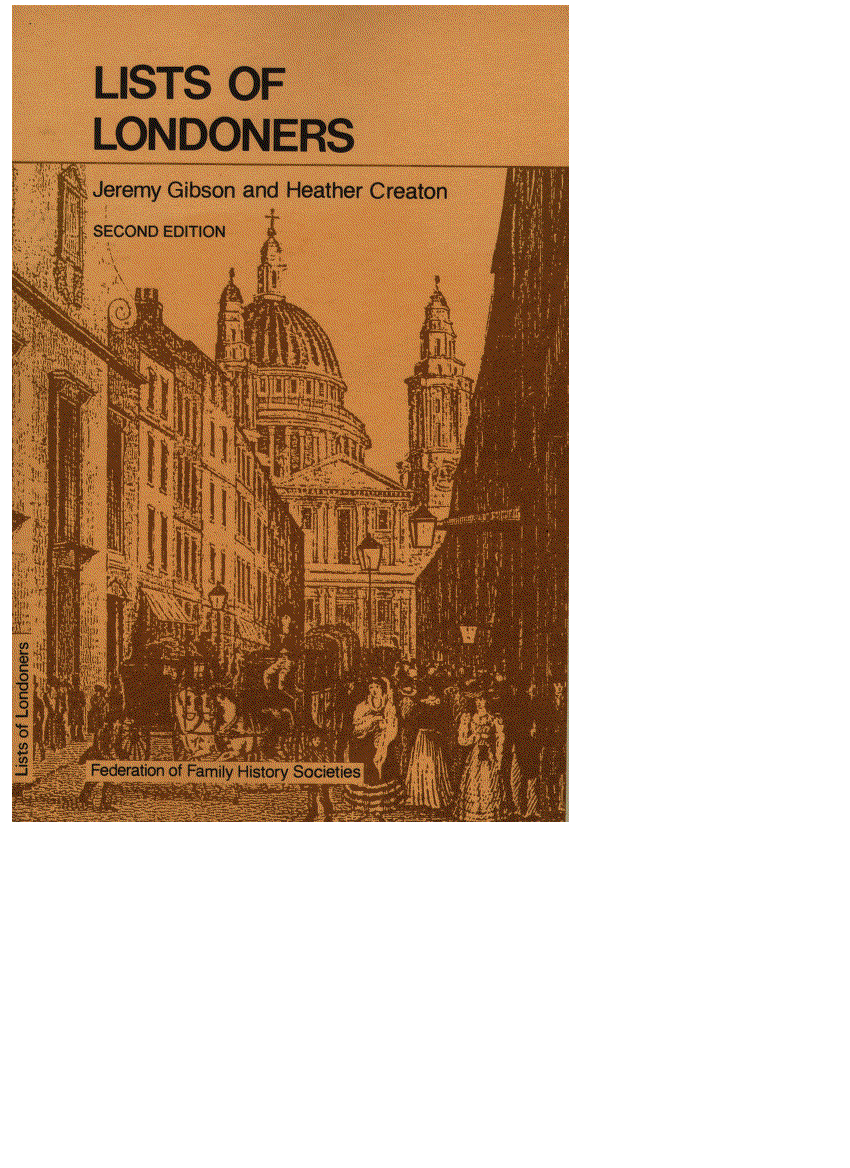
LISTS OF LONDONERS
Edited by Jeremy Gibson
and Heather Creaton
Published: 1st edition 1992,
reprinted 1993; 2nd edition 1997
Price: £2.50
A guide to unpublished lists and indexes containing information about London inhabitants of the past.
Published by the
Federation of Family History Societies in association with the
Centre for Metropolitan History
ISBN: 1 86006 047
1; paperback 210 x 149 mm; 40 pp.
Available from: Federation of Family History Societies, c/o Benson Room, Birmingham and Midland Institute, Margaret Street, Birmingham B3 3BS.
KENTISH DEMESNE ACCOUNTS UP TO 1350: A CATALOGUE
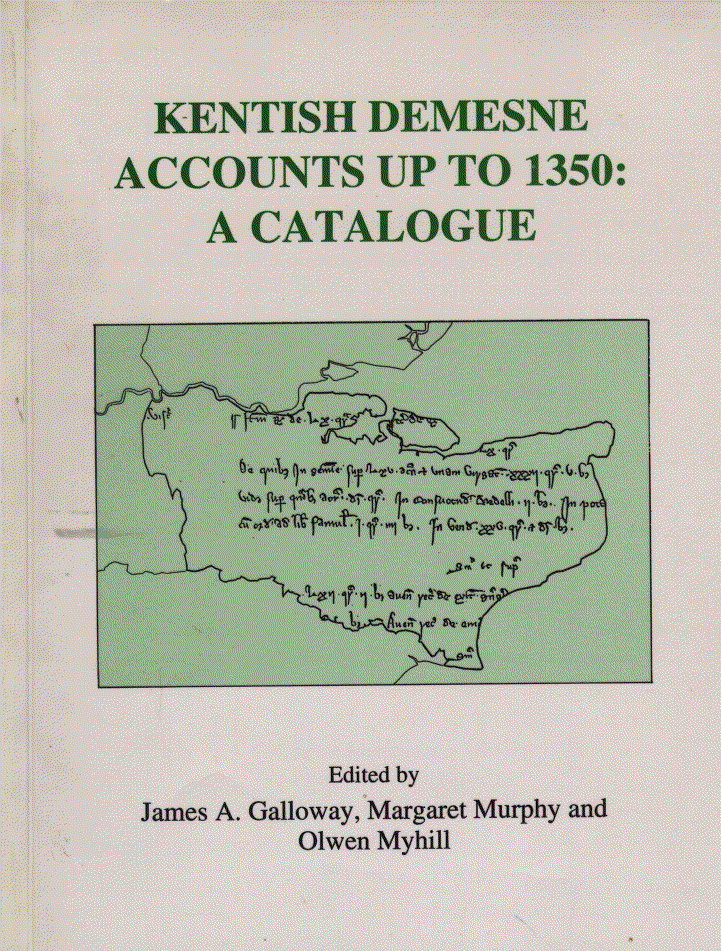
Edited by James A. Galloway, Margaret
Murphy and Olwen Myhill
Published: September 1993
Price: £2.50 (reduced from £5.50)
Demesne account rolls form the most important source for the history of English
agriculture in the Middle Ages. They provide a wealth of information on the
crops grown and livestock reared on manorial demesnes - those parts of manors
managed directly by or for their lords - as well as on prices, marketing, rents,
building expenses and many other aspects of rural life.
Kent is one of the counties for which surviving accounts are most abundant. This catalogue lists and describes just under 1,500 accounts relating to 100 Kentish manors in the period before the Black Death. In addition, there is a summary listing of accounts from the period 1350-1500 and indexes to parish and manor/place names, owners, and repositories. The catalogue, which brings together material from 16 different archives, will be of great value to students of particular places, to those planning county-wide studies, and to economic historians in general.
'The volume is attractively produced and the information clearly presented. It will be a godsend for any historian who wants to know what survives from medieval Kent' — Archives
Published by Centre for Metropolitan
History
ISBN 1 871348 17 X; paperback; 246 x 190 mm; xi, 66pp.
Available from: Publications Dept, Institute of Historical Research, Senate House, Malet Street, London WC1E 7HU. Tel: +44 (0)20 7862 8780. Email Sterling cheques made payable to 'University of London'. Credit card payment is also accepted.
BIBLIOGRAPHY OF PRINTED WORKS ON LONDON HISTORY TO 1939
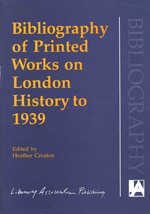 Edited by Heather Creaton
Edited by Heather CreatonThe history of London is so important in national and indeed international terms, it seems extraordinary that this is the first general bibliography of the subject to appear. It contains over 22,000 selected references to books and articles on the history of London, from the Dark Ages to the beginning of the Second World War. The whole of the former GLC area plus the City is covered. Arrangement is by subject, and there is a substantial analytical indes.
Material for the bibliography was collected from specialist libraries all over London and beyond. In it you can find everything from medieval medicine to 20th century architecture; from Chaucer to Virginia Woolf; from Civil War politics to Jack the Ripper, and much in between. It is a starting point for any enquiry about London's development over the centuries, whether from the academic historian, the amateur or the general enquirer.
Winner, The Library
Association's Besterman Medal, 1994
for an outstanding bibliography or guide to the literature
'The compilation is magnificent — reasonably comprehensive, authoritative and very well produced.' — Reference Reviews
'not only a feast for the London historian but also an unputdownable treasure trove for "the man on the Clapham omnibus"' — Journal of Librarianship and Information Science
'This is a volume not just of utility but of joy' — The Tablet
'No reference or research library will want to be without it. Scholars and lovers of London will find it equally indispensable, as well as engagingly diverting' — Australian Library Review
'a compendium of knowledge that is hard to put down, because it is so wide ranging' — Library Association Record.
'an admirable and invaluable publication' — Times Literary Supplement
Published by Library Association
Publishing Ltd.
ISBN: 1 85604 074 7; hardback, 248 x 184 mm; xxxiii, 809 pp.
Available from: Bookpoint Ltd, Mail Order Department, 39 Milton Park, Abingdon, OX14 4TD. Tel: +44 (0)1235 835001; Fax +44 (0)1235 400400/861038.
NOTE: This volume provided much of the core data for London's Past Online: a free, searchable online database of books, articles and other published material relating to the Greater London area from the Anglo-Saxon period.
LONDON AND SOUTHWARK INVENTORIES 1316-1650: A HANDLIST OF EXTENTS FOR DEBTS
 by
Martha Carlin
by
Martha Carlin
Published: December 1997
Price: £6.99
Household and commercial inventories are among the most evocative of sources for economic and social historians. They are especially important to those studying the medieval and early modern periods, since they can provide valuable evidence for many aspects of daily or economic life that are otherwise poorly recorded.
An extensive collection of medieval and early modern inventories of defaulting mercantile debtors in the Public Record Office has been little used. There are three overlapping collections of such debtors' inventories in the classes known as 'Extents for Debts' (C131, C239 and DL23).
This volume seeks to provide a handlist of all extents concerning real and personal property in the city of London and in Southwark. There are 1904 entries in all, dating from 1316 to 1650, with indexes to names, places, status and occupations of nearly 1600 individual debtors. It should be of interest and value to students of a wide range of disciplines.
'For London
historians of the period covered this book provides them with access to a potential
goldmine' — The Local Historian
'...Dr Carlin's book provides a powerful springboard to anyone studying the
lands and material possessions of Londoners, and those who held property in
London and Southwark, in the late medieval and early modern period, which will
save many hours of speculative research.' — The London Journal
Published by the Centre for Metropolitan
History
ISBN 1 871348. Paperback. xxvii, 103pp.
Please note: This publication is now out of print. Contact the Centre.
SOURCES FOR THE HISTORY OF LONDON, 1939-45: A GUIDE AND BIBLIOGRAPHY
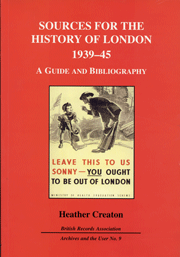 By Heather Creaton
By Heather CreatonThis volume aims to point readers to the enormous variety of primary sources available to the historian of the period, covering every conceivable aspect of London life. It also lists as many as possible of the printed works likely to be useful for information and analysis.
An introduction outlines the guide's aims and coverage; there is a brief resume of the chief events of the war as they affected London; the main types of records relevant to this subject - national and local government, businesses and institutions, diaries, letters, sound recordings, paintings, film and photographs - are discussed; a section looks at records documenting the ways in which London life was visibly changed by the war (evacuation, Air Raid Precautions, bomb damage and clearance, firefighting, post-raid welfare provision, large military presence, etc); a further section looks at records for 'business as usual' - the economy and work, morale, social life, food, entertainment and sport, law and order, education, health care, religion and the arts; and finally the guide examines sources about wartime planning for the future, and for the victory celebrations. Extracts from the documents are quoted wherever possible, to give a flavour of their coverage and the use that might be made of them. There is a subject index and a list of useful addresses.
The accompanying bibliography runs to over 950 items and includes contemporary writings as well as historical assessments. Some items are serious academic studies, others take a more popular approach. Many are personal accounts of wartime domestic or working lives written much later than the events they describe. All have something to offer the historian of London at this period. The bibliography follows the same subject groupings as the guide, and has its own index.
Neither the guide nor the bibliography can claim to be comprehensive, given the size of the subject, but they try to provide a starting point to stimulate others to further investigations.
'An excellent
source work... it will become a standard work on the subject' — Mary
Wilkinson, Imperial War Museum
'...a work that is much more than the modest "guide
and bibliography" that the title suggests. There are few such works I can recall
taking a pleasure in reading, but this one is spiced with quotat ions from the
sources and period illustrations....a guide that no London local history library
and record office can do without and one that should grace the shelves of anyone
interested in the history of the capital.' — David Mander, London Archi
ve Users' Forum Newsletter 41
'A list of facts and figures is excessively boring
although very necessary. The wealth of information that survives on this period
and place makes excessive facts essential. When they are dressed up in an entertaining
and informative text, however, they become not only palatable but act as signposts
to where you can rush off and find out more.... The book has a wealth of information
on what life was like, at the time of ration books and doodle-bugs, in the capital
which will be mirrored in other urban bombing targets. Knowing how things worked
and what organisations existed enables you to make an intelligent guess at what
to look at - as long as you know where to look for them. Heather Creaton has
packed a lot of information into a slim volume covering work as well as leisure,
and crime as well as defence....It is very thorough, very informative, well
presented and is a very good read even if you do not want to use the records
it recommends.' — Susan Lumas, Family History News and Digest, April
1999
'...this is not just a list of sources. Heather has written a lucid and entertaining
account of the various aspects of life on the home front... I recommend it as
a starting point for the study of the Second World War in London' — Mick
Scott, Lond on Journal, 24 no. 2 1999
'Local Historians from Cornwall to Northumberland would do well to read this
extensive guide — or, even better, emulate Creaton by producing similar
volumes for their own counties' — Stuart Raymond, The Local Historian,
February 2000
Published by the British Records
Association
ISBN 0 900222 12 3; Paperback, 246x172mm; xii, 196pp.; illus.
Available from: British Records Association, c/o London Metropolitan Archives, 40 Northampton Road, London EC1R 0HB. Please add p&p £1.75 UK, £2.75 overseas. Sterling cheques made payable to 'British Records Association'
NOTE: This volume provided some of the core data for London's Past Online: a free, searchable online database of books, articles and other published material relating to the Greater London area from the Anglo-Saxon period.
UNPUBLISHED LONDON DIARIES. A CHECKLIST OF UNPUBLISHED DIARIES BY LONDONERS AND VISITORS WITH A SELECT BIBLIOGRAPHY OF PUBLISHED DIARIES
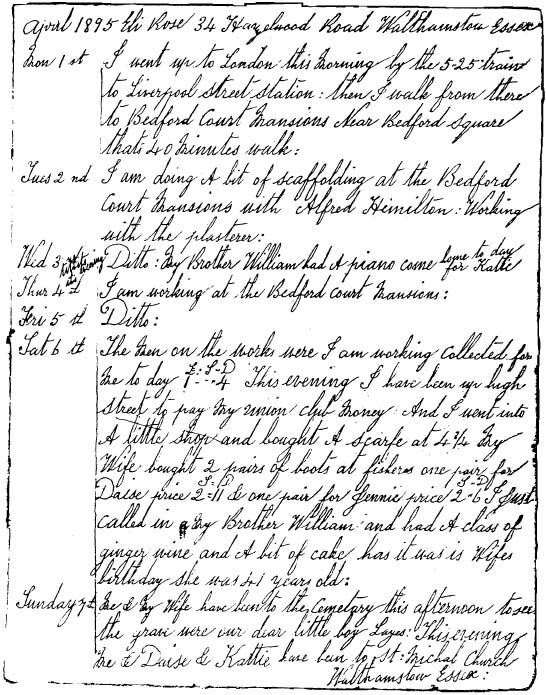 By Heather Creaton
By Heather CreatonIn a city of London's complexity and size, it can be difficult to pinpoint the experience of the individual at a specific period. Diaries, however, represent a valuable approach into this elusive world, presenting unique sn apshots of life in the city at different times and at varying social level. Diarists may concentrate on great events or on the comparative trivia of their everyday round, but they all convey some genuine flavour of London life that is hard to find in othe r sources. The minutiae of personal routines may yield detailed information about the practicalities of daily life too trivial to mention in more 'serious' writing, as well as giving insights into attitudes, expectations and behaviour in different social milieux. High politics to housework, childbirth to deathbeds, burglaries to bowel movements, all are recorded by diarists in this checklist. The compiler hopes that it will point all those interested in London history to the great range of underused, as y et unpublished diary material available in collections throughout this country and abroad.
This volume contains a list of 883 unpublished diaries, which endeavours to provide general guidance concerning the contents of each diary and includes an index to their writers and to their general subject content. A secon d checklist of 244 published diaries follows, indexed by writer and editor. An extended introduction gives an indication of the type of material to be found in the original documents.
Published by the London
Record Society
ISBN 0 90095237 7; Hardback, 245x149mm; vii, 136pp.; illus.
Available from: Hon. Secretary, London Record Society, c/o Institute of Historical Research, Senate House, Malet Street, London WC1E 7HU. Email
GAZETTEER OF MARKETS AND FAIRS IN ENGLAND AND WALES TO 1516
 By Samanatha Letters (with Mario Fernandes,
Derek Keene and Olwen Myhill)
By Samanatha Letters (with Mario Fernandes,
Derek Keene and Olwen Myhill)This is the printed version of the Gazetteer of Markets and Fairs to 1516 which is available online at http://www.history.ac.uk/cmh/gaz/gazweb2.html. It is a catalogue that aims to provide systematic information regarding the establishment and operation of markets and fairs in England and Wales from c.900 onwards. Every reference to a market or fair in the source material has been recorded. This includes both prescriptive (generally the oldes, which were held by established custom) and granted markets and fairs, which were usually held by virtue of a royal charter.
The English gazetteer is arranged by county, and then by place in alphabetical order; the Welsh gazetteer is arranged by place. Standard information is provided for each place, including an eight figure grid reference; whether the place was a medieval borough or had a mint in the Anglo-Saxon or Anglo-Norman periods (it is assumed that such places operated as centres of trade and had a market); its assessed value in the 1334 lay subsidy; whether the market or fair survived in the sixteenth century; and references to fuller accounts of its history. Over 2,300 places that had a market and/or a fair are listed listed.
The Gazetteer is a major reference work which will become a primary research tool for historians, historical geographers, economists, archaeologists and others. It will be of particular use to those undertaking local studies. The appeal of the Gazetteer will extend beyond those interested in the medieval period, as the markets and fairs established at this time formed the core of the network which survived into the sixteenth century and beyond.
Published by the List and Index
Society
Paperback, 297x210mm; 529pp.
Available from either: Publications Dept, Institute of Historical Research, Senate House, Malet Street, London WC1E 7HU. Tel: +44 (0)20 7862 8780. Email Sterling cheques made payable to 'University of London'. Credit card payment is also accepted. Please add £2 postage for UK addresses. Overseas postage rate on request;
or The Secretary, The List and Index Society, The National Archives, Kew, Surrey TW9 4DU (Email: ListandIndexSociety@pro.gov.uk)
Collections of Conference and Working Papers
EPIDEMIC DISEASE IN LONDON
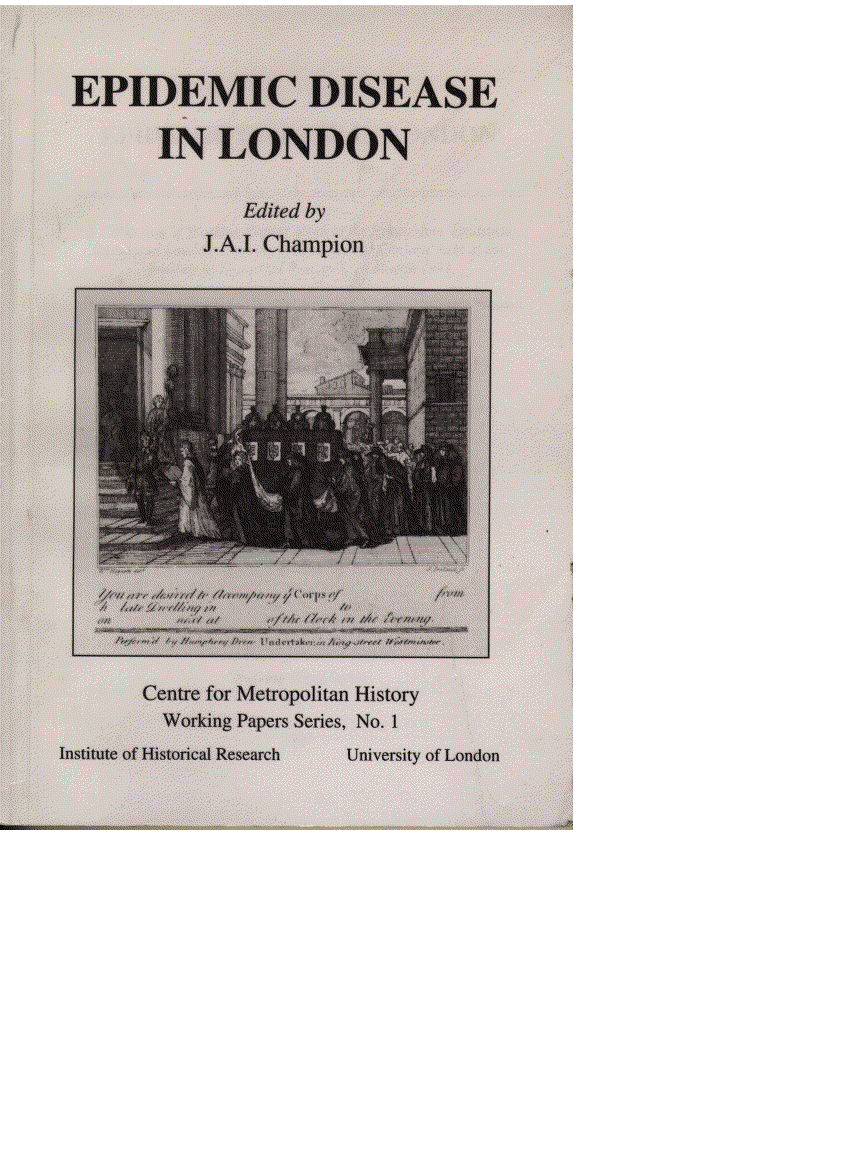
Edited by J.A.I. Champion
Published: 1993; Centre for Metropolitan History Working Papers Series No.
1
Price: £4.95
This collections of six papers originates from a symposium, held at the Institute of Historical Research in March 1992, on Epidemic Disease in London from the Black Death to Cholera. The essays included reflect the diversity of approaches discussed at the symposium and those currently being adopted in studying the relationship between disease and society. The collection, which both sets out the findings of on-going research projects and tries to outline some of the central methodological and historical concerns for future investigations, will be of value for the established scholar and the student embarking on new research into the history of epidemic disease.
Contents: 'Plague in London: spatial and temporal aspects of mortality' (Dr Graham Twigg); 'Discourses of the plague in early modern London' (Margaret Healy); 'Epidemics and the built environment in 1665' (Dr Justin Champion); 'Burial of the plague dead in early modern London' (Dr Vanessa Harding); 'The medical response to epidemic disease during the long eighteenth-century' (Dr Anne Hardy); 'Epidemics and skeletal populations: problems and limitations' (Dr Margaret Cox). A consolidated bibliography of published works cited by the authors also includes a selection of other works on epidemics and disease in London.
Published by the Centre for Metropolitan
History
ISBN 1 871348 18 8; paperback; 210 x 149 mm; vi, 88pp.
Please note: this publication is now out of print. An electronic version is available at this site, please click here.
GOLDSMITHS, SILVERSMITHS AND BANKERS: INNOVATION AND THE TRANSFER OF SKILL 1550 TO 1750
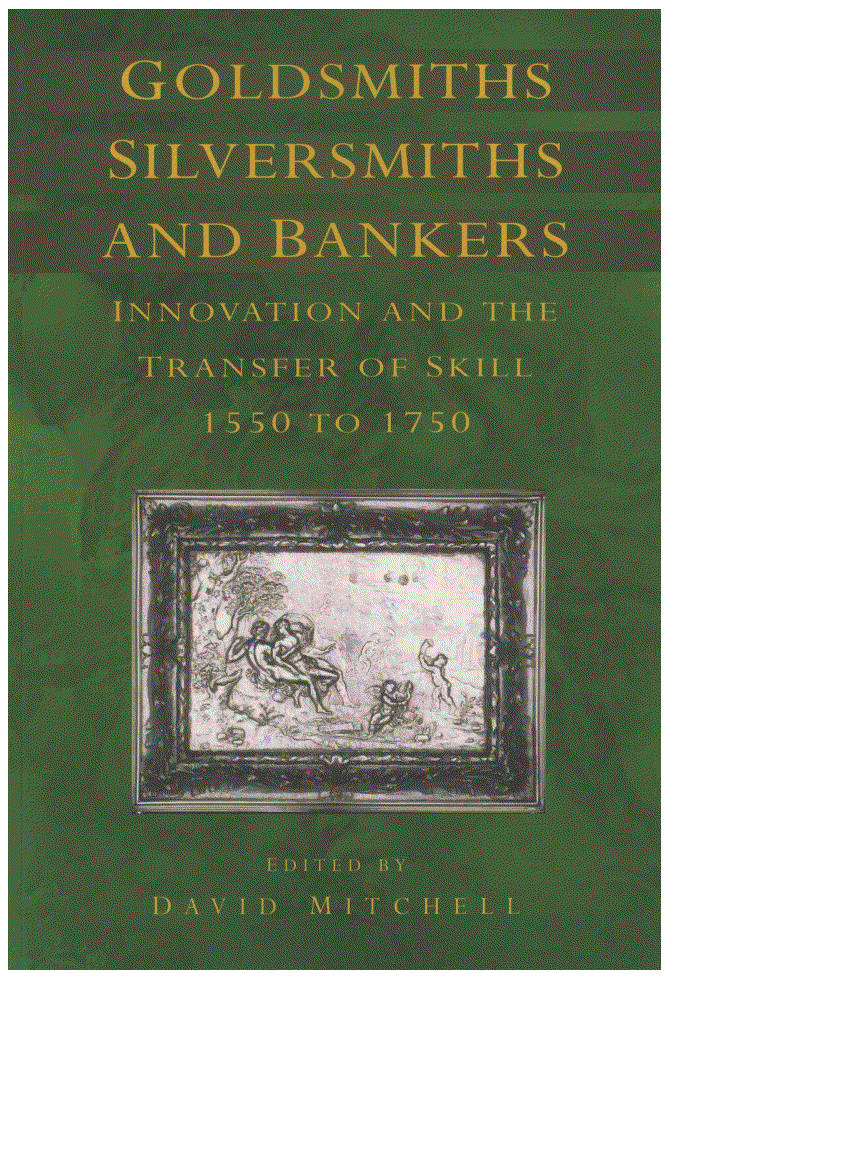
Edited by David Mitchell
Published: March 1995 (Centre for Metropolitan History Working Papers Series
No. 2)
Price: £9.99
This lavishly-illustrated collection of ten papers originates from a study day held at the Victoria and Albert Museum in November 1993, 'Innovation and Skill in Goldsmiths' Work'. The essays included here consider the many changes which took place between 1550 and 1750. In England, this period witnessed dramatic developments in the form and style of plate, in new consumer demand, in the organisation of manufacture, in the use of more focused sales techniques and in the expansion of the banking services provided by the goldsmith. The role of apprenticeship in the transfer of skill across the generations in three centres - Paris, Zurich and London - is discussed, together with the question of skill transfer between immigrant and native goldsmiths.
Contents: Introduction (Philippa Glanville); 'Innovation and the transfer of skill in the goldsmiths' trade in Restoration London (David Mitchell); Goldsmiths' apprenticeship during the first half of the seventeenth century: the situation in Paris (Michle Bimbenet-Privat); 'Training and workshop practive in Zurich in the seventeenth century' (Hanspeter Lanz); 'Aliens and their impact on the goldsmiths' craft in London in the sixteenth century (Lien Bich Luu); 'Balances and goldsmith-bankers: the co-ordination and contraol of inter-banker debt clearing in seventeenth-century London' (Stephen Quinn); 'The interaction between English and Huguenot goldsmiths in the late seventeenth and early eighteenth centuries' (Emma Packer); '"The King's Arms and Feathers". A case study exploring the networks of manufacture operating in the London goldsmiths' trade in the eighteenth century' (Helen Clifford); 'The design of London goldsmiths' shops in the early eighteenth century' (Claire Walsh); 'The goldsmiths and the London luxury trades, 1550 to 1750' (John Styles).
'..these essays represent essential reading for anyone interested in skilled industry in the early modern period' — Economic History Review
Published by Alan Sutton Publishing
Limited and Centre for Metropolitan History
ISBN 0 7509 0908 0; paperback; 248 x 172 mm; viii, 120pp.; 53 b&w illus.
Please note: This publication is now out of print. Contact the Centre.
ARCHIVES AND THE METROPOLIS

Edited by M.V. Roberts
Published: September 1998
Price: £13.99
A collection of twenty-six papers delivered at the 'Archives and the Metropolis Conference' in July 1996. The conference's aim was to increase understanding of the role of archives in metropolitan life and of the problems of providing for them. It explored the particular political, cultural, social, and economic contexts in which the archives have been created and maintained, throughout the world and from Antiquity to the present. The papers in this collection therefore address issues of wide general interest concerning cities, states and power.
Contents:
Metropolitan Archives, Ancient to Modern: 'Archives in the ancient world:
record-keeping, documents, and the "stone archives" of ancient Athens'
(Rosalind Thomas), 'Genoa and Lübeck: the beginnings of communal record-keeping
in two medieval trading metropolises' (Thomas Behrmann), 'The memory of a city:
the Vienna municipal archives from the thirteenth to the twentieth century'
(Ferdinand Opll), 'Three examples of Spanish metropolitan archives: Barcelona,
Seville, Madrid' (Miguel-Angel Ladero Quesada), Les Archives de Paris: mutilation,
démembrement, recomposition' (François Gasnault);
Non-Municipal Archives: 'Business archives: a sleeping giant of metropolitan
history' (Edwin Green), 'Records of metropolitan archaeology: unwanted residues
or primary sources?' (Nick Merriman), 'The stethoscope, the sewer and the patent
pill: medical records of the metropolis' (Christopher Hilton);
Medieval and Early Modern London: 'Records and record-keeping in medieval
London (Geoffrey Martin), 'From compact city to complex metropolis: records
for the history of London, 1500-1720' (Vanessa Harding);
Buildings, Furnishing and Use: 'Buildings, furnishing, access and use:
examples from the archive of the Venetian Chancery, from medieval to modern
times' (Claudia Salmini), 'Les archives de la ville de Marseille, problématique
d'un site' (Danielle Benazzouz), 'Planning a new home for the Budapest City
Archives' (András Horvath);
Metropolitan History from the Archives: 'The Historical Atlas of Vienna
as part of the Vienna History Project' (Renate Banik-Schweitzer), 'Stockholm
2002: how to write a city biography' (Lars Nilsson), 'A financial metropolis:
the City of London, 1815-1986' (David Kynaston);
Asia, Africa and the Americas: 'Tokyo metropolitan archives and historiography'
(Tamotsu Kumai), 'The fragmented past: archives in New York City, 1804-1996'
(Clifton Hood), 'Archives in Chicago?' (John Daly), 'Metropolitan archives in
federative countries: the case of Brazil' (Ana Maria de Almeida Camargo), 'Cairo:
its archives and history' (Raouf Abbas);
The Port of London: Archives and History: '"Liquid history":
the archive of the Port of London Authority' (Robert Aspinall), 'Using the Port
of London Authority archive for engineering and architectural history' (Peter
Guillery), 'Using the Port of London Authority archive for commercial history
(Sarah Palmer);
Metropolitan Archives in a Changing World: 'Moscow: the metropolitan
archive and political change (Vladimir a. Manykin), 'The metropolitan archive
in the twentieth century: the appraisal and destruction of files' (Jan Boomgaard)
Published by Guildhall Library
Publications in association with the Centre for Metropolitan History
ISBN: 0 900422 45 9; paperback, 248 x172 mm; xiv+210 pp., illus.
Available from: Guildhall Library Bookshop, Guildhall Library, Aldermanbury, London EC2P 2EJ (Tel: 020 7332 1858; Fax: 020 7600 3384; e-mail: Manuscripts.Guildhall@corpoflondon.gov.uk). Please add post and packing £2.80 UK, £3.50 overseas. Sterling cheques made payable to 'Chamberlain of London'.
TRADE, URBAN HINTERLANDS AND MARKET INTEGRATION c.1300-1600

Edited by James A. Galloway
Published: May 2000; Centre for Metropolitan History Working Papers Series
No. 3
Price: £10.00
The traditional division between the medieval and early modern periods in the realm of economic and social history has been increasingly questioned in recent years. For England, research on town populations, the commercialisation of society, and urban impact upon rural hinterlands in the middle ages has led to an appreciation of the parallels as well as the contrasts between the two periods, while new stress has been placed upon continuities in the country's marketing infrastructure.
The essays in this volume arise from a conference held in July 1999. They make a major contribution to the debate on continuity versus transformation in the period c.1300-1600 and present important new evidence on market integration and the structure of local and regional economies in the past. They consider the ways in which towns promoted change in the countryside - largely through economic influence in the case of London and other English towns, through a combination of economic and political domination in the German case-studies of Cologne and Nuremberg - and assess urban impact upon the organisation and stability of regional grain markets.
This volume will be required reading for all those interested in long-term economic change, in the influence of institutions upon the development of the market, and in the economic and political leadership of cities in later medieval and early modern Europe.
Contents: 'Urban demand in the English economy, 1300-1600' (Richard Britnell); 'One market or many? London and the grain trade of England' (James A. Galloway); 'Environs and hinterland: Cologne and Nuremberg in the later middle ages' (Herbert Eiden and Franz Irsigler); 'Changes in London's economic hinterland as indicated by debt cases in the Court of Common Pleas' (Derek Keene); 'Norwich, London, and the regional integration of Norfolk's economy in the first half of the fourteenth century' (Pamela Nightingale); 'Trade, urban hinterlands and market integration, 1300-1600: a summing up' (Christopher Dyer)
'...a high standard of scholarship has been maintained throughout and the production qualities of the volume are excellent...the volume provides a valuable opportunity for examining the very latest findings and approaches in this important field. Since the contributors are all experienced and innovative economic historians, it is no surprise that the collection is packed with novel insights and data' — Urban History Newsletter
Published by the Centre for Metropolitan
History, Institute of Historical Research
ISBN 1 871348 55 2; paperback; 248 x 172 mm; x, 110pp.
Please note: This publication is now out of print. It is now available online.
NEW WINDOWS ON LONDON'S PAST: INFORMATION TECHNOLOGY AND THE TRANSFORMATION OF METROPOLITAN HISTORY

Edited by Matthew Woollard
Published: December 2000; Association for History and Computing (UK)
Price: £8.00 (UK); £9.00 (Overseas)
Big cities — with their thronging populations, their endlessly replicated houses and households, their commerce and markets, and their elaborate systems of taxation and control — foster a culture of numbers and listing. For millennia, enumerat ion and record have been perceived as essential tools for governing and securing complex societies, above all in the metropolis. Totals of people, buildings, and of things consumed have likewise been central to the boosterish rhetoric of city description, and underpin many modern historians' and sociologists' attempts to explore and explain urban life. For urban historians the tools of information science and the computer fit into a recognisable intellectual tradition, but at the same time enormously enla rge the boundaries of what it is possible to explore. The essays and analyses in this collection range over some four centuries. The quantitative approach which characterises them is likely to retain a key role in metropolitan history, not least because it replaces estimation by certainty (or awareness of uncertainty) and so while answering some questions provides firm bases from which to pose new ones.
The first three papers arise from projects at the Centre for Metropolitan History and are based on presentations made at a study day on computing and metropolitan history held at the Centre in June 1998. The fourth arises from research based at the Cambridge Group for the History of Population and Social Structure and the University of Essex. All four essays demonstrate the striking historical insights which can be obtained, and the substantial resources created, by the use of simple and inexpensive computing techniques. This sort of historical com puting is of special value for its fundamental contribution to knowledge, for the clarity of its results, and for the resources created which enable future study of related issues.
Contents: 'Reconstructing London's distributive trade in the later middle ages: the role of computer-assisted mapping and analysis' (James A. Galloway); 'Computers, maps and metropolitan London in the 1690s' (Craig Spence); 'The epidemiological implications of reconstructing hospital catchment areas in Victorian London' (Graham Mooney); 'Families, work and households: the experience of Bethnal Green, 1891-1921' (Kevin Schürer).
Published by the Association for
History and Computing (UK)
ISBN 0 9539766 0 2; paperback; 210 x 146 mm; ix, 133pp.
Available from: Association for History and Computing (UK), The Subject Centre, 1 University Gardens, University of Glasgow, Glasgow G12 8QQ.
GUILDS, SOCIETY AND ECONOMY IN LONDON 1450-1800
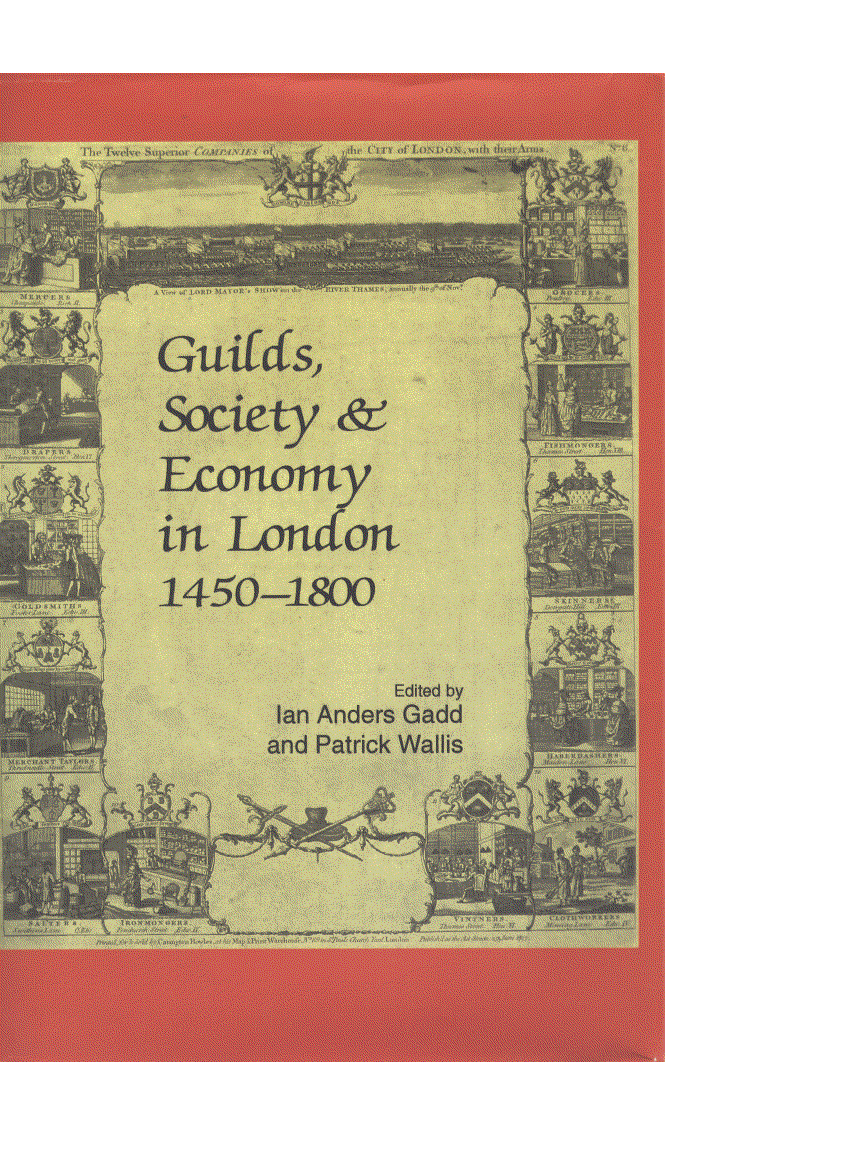
Edited by Ian Anders Gadd and Patrick
Wallis
Publication Date: 12 April 2002
Price: £14.00
A collection of papers from the 'Revisiting the Livery Companies of Early Modern London' conference held in April 2000, exploring the history of London livery companies from a variety of perspectives. Employing historical and interdisciplinary approaches, contributions examine print culture and early histories, civic myths, charity, the family, artisans, mercantile elites, and the control and regulation of guild and economy.
'There are no weak links here...These essays have added considerably to our understanding of the development of the London companies in the early modern period, adding new layers of sophistication to nuance, and occasionally subvert, conventional wisdom...they will have established a framework, or set of frameworks, for future work, which must now commence from a very different starting point indeed...This collection reaffirms the crucial importance of the early modern period as one of transition, with quantitative change in the first half evolving into qualitative change in the second.' — Reviews in History
Published by Centre for Metropolitan
History, Institute of Historical Research, in association
with Guildhall Library (Corporation of London)
ISBN 1 871348 65 X; Hardback; 204 pp; illus.
Available from: The Publications Department, Institute of Historical Research, University of London, Senate House, Malet Street, London WC1E 7HU. Tel: +44 020 7862 8780; email (Please add £2 for postage to UK addresses. Sterling cheques made payable to 'University of London'. Credit card payments are also accepted.)
RE: THE ARCHIVE, THE IMAGE, AND THE VERY DEAD SHEEP
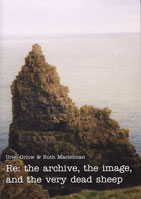
By Uriel Orlow & Ruth Maclennan
Publication date: 12 November 2004
Price: £10.00 (£2.00 postage UK)
This book was produced, along with a poster and a video also by Orlow & Maclennan to accompany the conference 'Unleashing the Archive' held at Senate House, University of London, on 12 November 2004. This book starts on one side with a correspondence between the authors, writing to each other while on holiday on the North-East coast of Scotland and in Zurich and the Swiss Alps. The contrasting landscapes form the backdrop of a meandering discussion inspired by the archive. Drawing on documented, anecdotal and imagined histories of their surroundings the correspondents produce associative genealogies, mapping thought, image, object and experience. Seeking correspondences between what has been, what might have been and what could arise they speculate on pre-archival moments and the archive's aftermath. This idiosyncratic historiography brings together Cabaret Voltaire, Pictish burial mounds, Lenin, Joyce, the Gulf Stream and the Rosetta Stone.
The correspondence is expanded with commentaries and annotations by other voices. These include a text on Finnegans Wake, the Pentland Firth, the lyrebird song and holiday resorts.
The book is complemented by a thesaurical collection of images inspired by the correspondence. The images generate their own references and associations while also pre-figuring the text. Thus the images form an autonomous yet related image-archive. This, together with an index listing keywords and names from the book and a bibliography perform the role of an archive-catalogue which provides an alternative entry to the book.
Published by Bookwork
and sponsored by the School of Advanced
Study (University of London), The National Archives
and Double agents (Central Saint Martins College of Art and Design)
ISBN 0 9548947 0 7; 169mm x 120mm; softback with dust jacket; 160pp.; b/w illus.
Available from: Publications Dept, Institute of Historical Research, Senate House, Malet Street, London WC1E 7HU. Tel: +44 (0)20 7862 8780. Email Sterling cheques made payable to 'University of London'. Credit card payments are also accepted.
GUILDS AND ASSOCIATION IN EUROPE, 900–1900

Edited by Ian A. Gadd and Patrick Wallis
Publication Date: 31 December 2006
Price: £15.00
A selection of papers from the 'Guilds: London...England...Europe...' conference held in 2003, these essays engage with guilds as part of the much wider variety of associations and associational cultures that existed in Europe between the tenth and nineteenth centuries. Together, they demonstrate the vitality and the importance of extending the remit of guild scholarship to include periphery as well as core, their afterlife and anticipations as well as their time of fullest flourishing.
Contents:
Derek Keene: English urban guilds, c.900-1300
Gervase Rosser: Guilds in urban politics in late medieval England
Lars Edgren: Swedish guilds in the righteenth and early nineteenth century
Margaret Pelling: Parliament, the Navy and the splitting of the London Barber-Surgeons' Company in 1745
Philippe Minard: French debates about restoring guilds at the start of the nineteenth century
Johan Dambruyne: Representation and investment strategies in the early modern guild world
David Marsh: The Gardeners' Company of London in the seventeenth century
George J. Sheridan, jr: The silk weavers of nineteenth-century Lyon
Sigrid Wadauer: Journeymen's mobility and the guild system
Malcolm Chase: The guild tradition and the emergence of British trade unionism
Published by Centre for Metropolitan
History, Institute of Historical Research
ISBN 978 1 905165 13 1; Paperback; 224 pp; illus.
SPECIAL OFFER:
Buy with Guilds, Society and Economy in London
1450-1800 for £20.00 (a combined saving of £9.00)
Available from: The Publications Department, Institute of Historical Research, University of London, Senate House, Malet Street, London WC1E 7HU. Tel: +44 020 7862 8780; email (Please add £2 per copy for postage to UK addresses, £3 for overseas. Sterling cheques made payable to 'University of London'. Credit card payments are also accepted.)
Monographs
A MEDIEVAL CAPITAL AND ITS GRAIN SUPPLY: AGRARIAN PRODUCTION AND DISTRIBUTION IN THE LONDON REGION c.1300
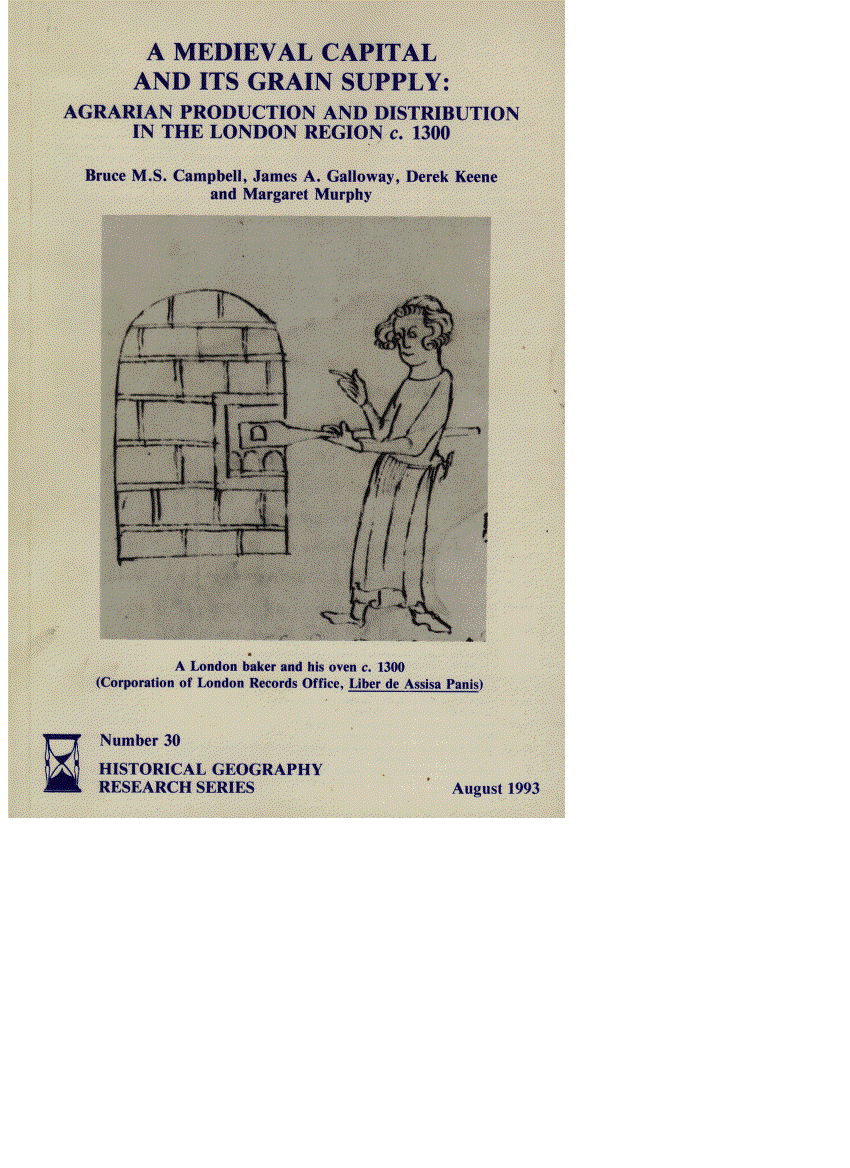
by Bruce M.S. Campbell, James A. Galloway,
Derek Keene, and Margaret Murphy
Published: 1993; Historical Geography Research Group, Research Paper Series
No. 30
Price: £14.95 (incl. p+p)
At its peak, around 1300, medieval London was in the second rank of west European cities, and by far the largest city in Britain. Combining innovative methods of analysing the abundant records of the period with theoretical approaches based in economic geography, the study assesses the impact of London's demand for grain on production and distribution in its region.
Topics explored include: the output of medieval agriculture and the size of population it could sustain; the character of the metropolitan market and the transport systems which supported it and the role of London and other sources of demand (including the international market) in promoting the development of intensive agriculture.
'... provides a wealth of detail on the agrarian structure of the London region at the beginning of the fourteenth century, and it deserves to be widely read' — Journal of Historical Geography
'Meticulously focused and methodologically bold, the authors attempt to join technical issues in medieval agrarian productivity to problems of urbanization' — American Historical Review
'...a first-class analysis of what was happening in the demesne sector...' — The Agricultural History Review
'It replaces everything previously written on the subject' — Speculum
Published by the Historical Geography
Research Group
ISBN 1 870074 12 2 Paperback, 210 x 149 mm; x, 233 pp; 29 figures, 19 tables
Available from:Dr Elizabeth Gagen, Department of Geography, University of Hull, Cottingham Road, Hull HU6 7RX, UK. Sterling cheques made payable to 'Historical Geography Research Group'. Email; HGRG publication details
LONDON'S DREADED VISITATION: THE SOCIAL GEOGRAPHY OF THE GREAT PLAGUE IN 1665
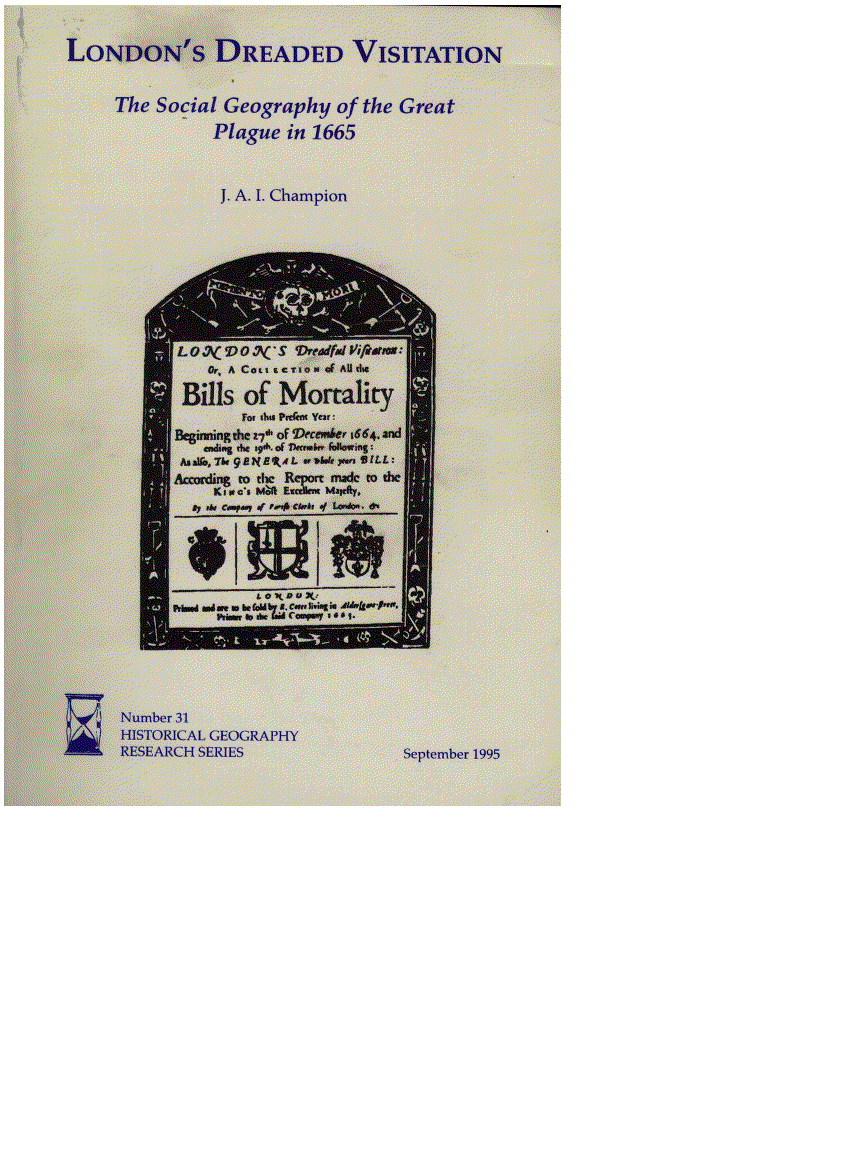
by J.A.I. Champion
Published: September 1995 Historical Geography Research Series No. 31
Price: £7.95 (incl. p+p)
Using data derived from tax assessments, the Bills of Mortality, burial registers and churchwardens' accounts, this study explores the complex relationship between the various patterns of death — seasonal, sexual and spatial — and the diverse social, environmental and economic characteriestics which the metropolis exhibited during the 'Great Plague' epidemic of 1665. Both the general impact of the crisis on Restoration london and Westminster, and the widely varying experiences of ten sample parishes, are examined and illustrated by maps, graphs and tables.
'this challenging and questioning study should be a stimulus for further research' — The London Journal
Published by the Historical Geography
Research Group
ISBN: 1 870074 13 0; paperback, 210 x 149 mm, xiv, 124 pp.; 34 figures, 27 tables.
Available from: Dr Elizabeth Gagen, Department of Geography, University of Hull, Cottingham Road, Hull HU6 7RX, UK. Sterling cheques made payable to 'Historical Geography Research Group'. Email; HGRG publication details
LONDON IN THE 1690S: A SOCIAL ATLAS
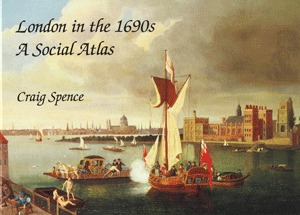
By Craig Spence
Publication date: December 2000
Price: £19.95
At the end of the seventeenth century London was about to become the largest and wealthiest city in the western world. One in ten of England's population lived in the capital, which also housed a vast proportion of the kingdom's riches. That wealth, combined with the great international trade flowing through its wharves and warehouses, earned the city the description 'the vitals of the commonwealth'. Analysing the unique and extensive documentary sources for this significant decade, the author describes and explores a number of key topographic, social and economic measures. Importantly, and so far as the sources allow, seventeenth-century London is treated throughout the analysis as a single entity - a metropolis, comprising the City and the sprawling suburbs outside.
London in the 1690s guides the reader through the development of the built environment and the vital economic and social patterns indicated by the property values and the density of households. It includes discussion of London's élite, the distribution of male and female householders, and broad patterns of wealth. Supported by extensive statistical tables and maps, the books is also illustrated with images from the period. This fascinating atlas makes a major contribution to the field of early modern urban studies, and will interest both the established scholar and the student. It also serves as an introduction to the extensive databases on the decade held at the Centre for Metropolitan History.
‘It is a remarkable achievement; this atlas must form a cornerstone of all subsequent work on the social and occupational geography of London for a good time before and after the 1690s’ — Urban History
‘It is a superlative work of historical geography... Scholars of many subjects – from demography to commerce to the built environment – will welcome this book as a substantial achievement in metropolitan history’ — English Historical Review
‘This atlas is a substantial demonstration of the power of computer-aided cartography in the analysis of complex spatial data... Whether researchers are interested in the metropolis as a whole or in its constituent parts this atlas is a mine of new and carefully sifted information’ — The London Journal
‘...provides a fascinating insight into London life... An attractively illustrated account of London at a crucial point in its development... A must for your local studies centre and a very nice addition to your own bookshelves.’ — London Archive Users’ Forum Newsletter
Published by Centre for Metropolitan
History, Institute of Historical Research
ISBN 1 871348 57 9; 295 x 210mm; hardback; xii, 200pp.; 78 figures, 30 tables.
Available from: Publications Dept, Institute of Historical Research, Senate House, Malet Street, London WC1E 7HU. Tel: +44 (0)20 7862 8780. Email Sterling cheques made payable to 'University of London'. Credit card payments are also accepted.
CLERGY IN LONDON IN THE LATE MIDDLE AGES: A register of clergy ordained in the diocese of London based on episcopal ordination lists 1361-1539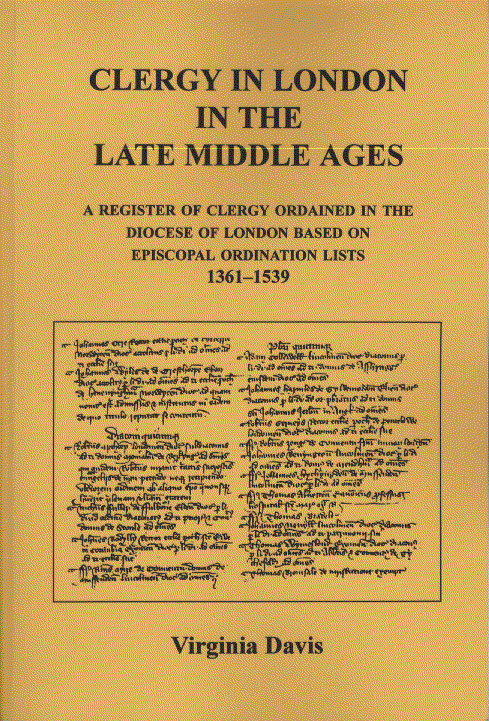
By Virginia Davis
Publication date: 22 December 2000
Price: £14.95 including CD-ROM
By the standards of what is known of most men and women in the middle ages the English clergy are very well documented. Most information, however, survives for those who were either successful in attaining high office or those who attracted criticism from contemporaries. The bulk of the medieval clergy, especially the unbeneficed, are less well served by the records. An important source which systematically records all clergy, humble or exalted, is the ordination lists which exist in mnay late-medieval bishops’ registers. Despite their value for prosopographical studies of the clergy many of the ordination lists remain unedited and individuals have to be sought in the often closely written folios of the bishops’ registers. Their structure, however, with a fairly standardised format which provides information about many thousands of ordinands, makes them highly suitable for computerisation.
This book and CD-ROM make available - in machine-readable form - the contents of all the surviving medieval London episcopal ordination lists. The CD-ROM contains two textbases which together provide the ordination details of just over 30,000 records of secular and regular clergy from 1361 to 1539. Each record consists of a single ordination of a single individual cleric. Two-thirds of the entries are for secular clergy and the remaining third relate to members of religious orders. The date range covers the period from the earliest surviving London lists to the short-lived Henrician re-organisation of the diocese in 1540. From the disk, information concerning either named individuals or specified groups may be extracted, for example, information about a particular group of clergy such as all the monks of one religious house or all the men from a particular diocese ordained in London or all the vicars- choral of a specified cathedral. Viewed as a whole, the lists allow examination of trends in clerical demography and of clerical mobility, in particular migration into London from elsewhere in the country.The textbases and accompanying Idealist software on the CD-ROM make available for the first time - in a user-friendly format - the names and ordination details of all men recorded as being ordained in the diocese of London in the later middle ages. The accompanying volume provides a valuable introduction to the ordination lists as sources and to clerical recruitment trends in London between the Black Death and the Reformation. Together they make a valuable contribution to the history of the late medieval English church.
‘Hidden in the slim volume is a massive source edition, an extensive research resource for everyone interested in the late medieval English Church...This edition is the impressive result of what must have been a long and complicated, perhaps pioneering, project’ — Journal of Ecclesiastical History
Published by Centre for Metropolitan
History, Institute of Historical Research
ISBN 1 871348 59 5; 172 x 246 mm; paperback; x, 76pp.; CD-ROM
Available from: Publications Dept, Institute of Historical Research, Senate House, Malet Street, London WC1E 7HU. Tel: +44 (0)20 7862 8780. Email Sterling cheques made payable to 'University of London'. Credit card payments are also accepted.
THE HISTORY OF THE MERCHANT TAYLORS' COMPANY
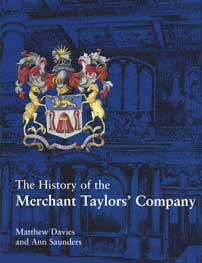
By Matthew Davies and Ann Saunders
Publication date: 28 June 2004
Price: £49.50; US$80
One of the 'Great Twelve' livery companies of the City of London, the Merchant Taylors' Company has been in existence for some seven hundred years. This new history charts the remarkable story of the Company and its members from its origins until the 1950s, encompassing the lives and achievements of men such as Sir Thomas White (founder of St John's College, Oxford) and the celebrated chronicler, John Stow, as well as the roles played by the Company in the City and beyond in different periods.
As well as looking in detail at the internal life of the Company, the book focuses on a number of important themes in the wider history of London. These include trade and industry, apprenticeshi, the impact of religious change, the foundation of schools and other charities, and the government and politics of the City. In doing so, the book contributes to an understanding of the aims and activities of the livery companies over the centuries, their ability to adapt to changing circumstances and their relevance in a modern world far removed from that in which they were first established.
CONTENTS
Part One: The Medieval Company — Origins: Tailors and Linen-Armourers; 'Ghostly Treasure': The Fraternity of St John the Baptist 1350–1500; The Government of the Medieval Company; The Company and the Craft; Company, City and Crown 1350–1500
Part Two: Reformation to Restoration — The Company and the Reformation; The Company and Education in the Sixteenth Century; Daily Life in Elizabethan London; The Clothworkers, the City and the Crown; The Turn of the Century; Prelude to the Civil War; The Company in the Civil War; Restoration, Fire and Rebuilding; Troubled Times
Part Three: The Company in the Modern World — The Long Eighteenth Century; The Nineteenth Century; The Twentieth Century
The History of the Merchant Taylors' Company will appeal to a wide range of people interested in the history of London. It is fully illustrated with 98 black and white and 30 colour illustrations. It is attractively bound in cloth with a full colour dust jacket and matching cloth slipcase.
Published by Maney Publishing
ISBN 1 902653 99 8; 272mm x 220mm; hardback; 304pp.; 98 b/w + 30 colour illus.
Available from: Publications Sales Department, Maney Publishing, Hudson Road, Leeds LS9 7DL UK. Tel: +44 (0)113 249 7481; Fax: +44 (0)113 248 6983 Email Website: www.maney.co.uk
Collective Volumes
ST PAUL'S: The Cathedral Church of London 604-2004
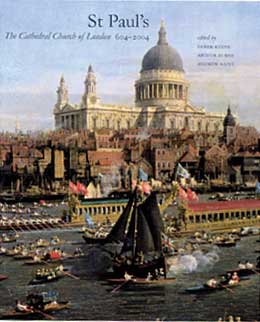
Edited By Derek Keene, Arthur Burns
and Andrew Saint
Publication date: 24 April 2004
Price: £65.00
As London's mother church, St Paul's cathedral has for long been the dominant symbol of the city and of its survival through adversity, including warfare and numberous fires. By virtue of its situation in the capital, St Paul's has shaped the English church and state. Besides its position in the hierarchy of the church, the wealth of its estates in earlier times and its connection to monarch and government, the cathedral has enjoyed a profound link with the city and people of London. These relationships, often controversial, give St Paul's its unique character among English cathedrals.
Of the four or more great churches that have occupied the site, the last two have by their scale and architectural quality been fully equal to the significance of St Paul's as an institution. In particular, the familiar image of the present church and its dome has stood internationally for London and the nation. The masterpeice of St Christopher Wren, this is the only cathedral of world renown to have been designed and completed by a single architect.
This wide-ranging and comprehensive account is based on the most recent research and thinking about St Paul's and London, as well as the church in England. Contributed by forty-two authors, the book unites specialised studies with a series of historical overviews. Topics covered include the clergy and lay people associated with St Paul's; their intellectual life, interests and responsibilities; liturgy and music; patterns of devotion and commemoration; architecture, decoration, furnishing and conservation; the endowment and income of the cathedral; its role as a landlord and as a patron of other churches; and the public role of St Paul's in both city and state.
The present diocese and the first cathedral of St Paul's were founded in 604 and this book marks their 1400th anniversary. Lavishly illustrated and annotated, it is a major work of reference and a fascinating history of an institution that has represented England to the world for more than a millennium.
'Fascinating...an utterly compelling new book...The illustrations, some familiar, many more shown here for the first time, are stunning, though one almost hesitates to say so, as this is so much more than a picture book...This book is what Wren and his family wanted: a lasting monument worthy of the man and of his emblematic building' - The Times
'[A] visually delicious book...a distinguished roll call of academics and experts have risen to the challenge of creating a very serious history for a wide audience' - BBC History Magazine
'Every essay is of interest, none is off-puttingly technical, and the book is sumptuously and informatively illustrated' - The Sunday Telegraph
'a volume of such splendour and scholarly weight...that it is almost impossible to do it justice' - Country Life
Winner of the William MB Berger Prize for British Art History, 2004
Published by Yale University Press
ISBN 0 300 09276 8; 335mm x 255mm; hardback; 538pp.; 150 b/w + 240 colour illus.
Available from: Sales Department, Yale University Press, 47 Bedford Square, London WC1B 3DP. Tel: 020 7079 4900; Fax: 020 7079 4901. Email and all good bookshops.
NEW
REINVENTING HISTORY: THE ENLIGHTENMENT ORIGINS OF ANCIENT HISTORY

Edited by James Moore, Ian Macgregor Morris, Andrew J. Bayliss
Publication Date: 31 December 2008
Price: £25.00
The eighteenth century was a critical period for the development of historical writing. Revolutions in archaeology, historical methodology and source criticism brought dramatic changes to our understanding of the ancient world. There were new debates about the value and purpose of history and new historical canons emerged that were to determine the nature of scholarly historical writing for more than a century.
This volume examines these changes through an analysis of the nature of historical narrative, debates about sources, methods and material culture, and through the ‘political’ uses of history in eighteenth-century constitutional debate. The development of these interpretations and approaches would become the defining feature of Enlightenment engagement with antiquity. Moreover, they would lay the foundations of the modern discipline of Ancient History. This is a book that challenges traditional accounts of historiographical development and highlights how the politics of scholarly culture have distorted views of the ancient past.
Contents:
James Moore and Ian Macgregor Morris: History in Revolution? Approaches to the Ancient World in the Long Eighteenth Century
Doohwan Ahn: Xenophon and the Greek Tradition in British Political Thought
Peter Liddel: William Young and the Spirit of Athens
John Seed: 'The deadly principles of fanaticism': Puritans and Dissenters in Gibbon's Decline and Fall of the Roman Empire
Carsten Hjort Lange: The Battle of Actium and the 'slave of passion'
James Moore: History as Theoretical Reconstruction? Baron D'Hancarville and the Exploration of Ancient Mythology in the Eighteenth Century
Malcolm Wagstaff: Colonel Leake and the Historical Geography of Greece
Gareth Sampson: The Rise and Fall of the Roman Historian: The Eighteenth Century in the Roman Historical Tradition
Andrew J. Bayliss: Greek, but not Grecian? Macedonians in Enlightenment Histories
Ian Macgregor Morris: Navigating the Grotesque; or, Rethinking Greek Historiography
Published by Centre for Metropolitan
History, Institute of Historical Research
ISBN 978 1 905165 37 7; Hardback; 328 pp; illus.
Available from: The Publications Department, Institute of Historical Research, University of London, Senate House, Malet Street, London WC1E 7HU. Tel: +44 020 7862 8780; email (Please add £2 per copy for postage to UK addresses, £3 for overseas. Sterling cheques made payable to 'University of London'
THE RELIGIOUS HOUSES OF LONDON AND MIDDLESEX
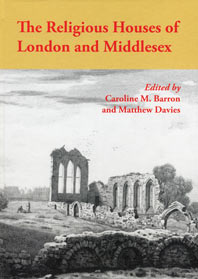
Edited by Caroline M. Barron and Matthew
Davies
Publication Date: 17 May 2007
Price: £20.00
This volume brings together, for the first time, the remarkably detailed accounts of the sixty-five religious houses in London and Middlesex that were originally published by the Victoria County History in 1909 and 1969. These range from the larger and better known houses, such as Westminster abbey, to the many small cells and hospitals that were founded in and around London in the centuries before the Reformation. New material has been added for every house in the form of brief guides to recent research, along with revised lists of the heads of these institutions up to the Dissolution. There is also an entirely new introduction, which explores the significance of the religious houses in the spiritual and social life of the city and county during the half millennium of their existence.
The Editors: Caroline M. Barron is Professorial Research Fellow in History at Royal Holloway, University of London. Matthew Davies is Director of the Centre for Metropolitan History, and Reader in London History, at the Institute of Historical Research, University of London.
Published by the Centre for Metropolitan
History and Victoria County History, Institute of Historical Research
ISBN 978 1 905165 12 4; Hardcover; 210×297 mm; 352 pp; illus.
Available from: The Publications Department, Institute of Historical Research, University of London, Senate House, Malet Street, London WC1E 7HU. Tel: +44 020 7862 8780; email (Please add £2.50 per copy for postage to UK addresses, £5 for overseas. Sterling cheques made payable to 'University of London'. Credit card payments are also accepted.)
[History Home Page] [CMH Home Page] [CMH Projects] [Annual Reports]